Bitcoin
step by step guide by a16zcrypto
Published
1 month agoon
By
admin
From network tokens to meme coins, a16z crypto has laid out a framework to help businesses navigate the evolving crypto landscape.
What is a cryptocurrency? According to Wikipedia’s definition, it is a digital currency designed to work through a computer network that is “not reliant on any central authority, such as a government or bank, to uphold or maintain it.”
And while at the very beginning in 2009 there was one and only cryptocurrency out there, called Bitcoin (BTC), things have changed significantly since then. Now, there over 12 million different tokens, per data from crypto price aggregator platforms. But how to differ them? There are memecoins, utility tokens, security tokens, and many more. No wonder crypto has become so complex.
“So, whether you’re building a blockchain-based project, investing in tokens, or simply using them as a consumer, it’s essential to know what to look for. It’s important not to confuse, for instance, memecoins with network tokens.”
a16z crypto
To help sort the crypto things out, Miles Jennings, Scott Duke Kominers, and Eddy Lazzarin from a16z crypto created a framework for understanding the seven categories of tokens they see entrepreneurs building with most often. Below is a breakdown of these categories.
Network tokens
Network tokens are used to keep a blockchain or smart contract protocol running. Basically, their value comes from how the network works. They usually have a clear purpose, like helping with network operations, forming consensus, upgrading the protocol, or rewarding certain actions within the network.
As a16z crypto explains, these networks, where the tokens live, usually have features like “programmatic buybacks, dividends, and other changes to the total token supply via token creation or burning to introduce inflationary and deflationary pressures in service of the network.”
Network tokens depend on trust. And in this aspect a16z crypto says these tokens “are similar to both commodities and securities.”
“Recognizing this, both the SEC’s 2019 Framework and FIT21 provided for network tokens to be excluded from U.S. securities laws when those trust dependencies are mitigated through decentralization of the underlying network.”
a16z crypto
These tokens are used to launch new networks, distribute ownership or control, and keep the network secure. The brightest examples are Bitcoin, Ethereum (ETH), Solana (SOL), Uniswap (UNI), and Dogecoin (DOGE).
Security tokens
While network tokens might seem like securities, security tokens are actually digital versions of traditional securities, like company shares or corporate bonds. They can also have special features, like giving profits interest in an LLC or rights to future settlement payments from lawsuits.
While securities give holders specific rights, titles, or interests, and the issuer often controls the asset’s risk, these tokens will still be under U.S. securities laws, as a16z crypto points out. Even though these tokens aren’t as common as network tokens or memecoins, they’ve still been used to raise money for business ventures.
For example, Etherfuse Stablebonds and Aspen Coin gave people fractional ownership in the St. Regis Aspen Resort.
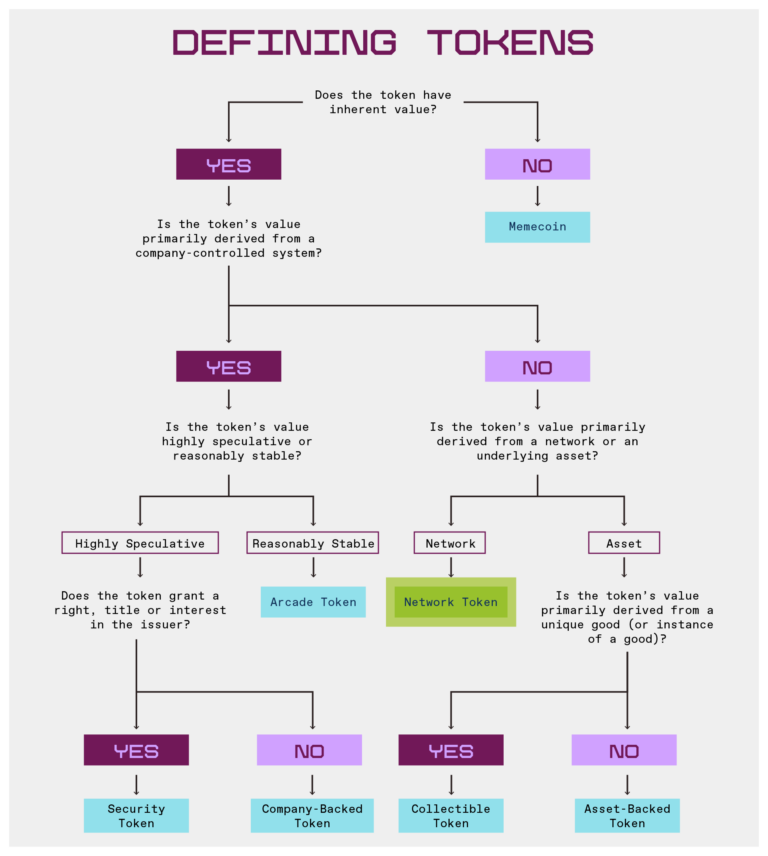
Company-backed tokens
Company-backed tokens are tied to an off-chain application, product, or service run by a company or centralized organization.
Like network tokens, company-backed tokens may use blockchain and smart contracts (e.g., to facilitate payments). However, they primarily serve off-chain operations rather than network ownership. As a result, a company has more control over the issuance, utility, and value of the token.
Although these tokens don’t provide a defined right or title like traditional securities, they still have trust dependencies akin to securities.
“Their value is inherently dependent upon a system that is controlled by a person, company or management team.”
a16z crypto
For this exact reason, company-backed tokens could be subject to U.S. securities laws when they attract investment, the analysts warn. Historically, company-backed tokens have been used to circumvent securities laws in the U.S., acting as proxies for equity or profits interests in companies.
For instance, examples include (FTT), which was a profit interest in the notorious FTX exchange. Binance Coin (BNB) is another example of a company-backed token that transitioned into a network token after the launch of BNB Chain.
Arcade tokens
Arcade tokens are primarily used within a system and are not meant for investment, a16z crypto explains. These tokens often serve as currencies within virtual economies, like digital gold in a game, loyalty points for a membership program, or credits for digital products.
What makes arcade tokens unique is that they are designed to discourage speculation. They may have an uncapped supply — meaning an unlimited number can be minted — and/or limited transferability.
As a16z crypto points out, these tokens may even “expire or lose value if unused, or they may only have monetary value and utility within the system in which they are issued.” As a rule, arcade tokens don’t promise financial returns, which makes them relatively safe from U.S. securities laws.
Examples include FLY, the loyalty token for the Blackbird restaurant network, and Pocketful of Quarters, an in-game asset that received relief from the U.S. Securities and Exchange Commission in 2019.
Collectible tokens
One of the most well-known types of tokens are collectible ones. They can represent things like a work of art, a music piece, or even a concert ticket stub. But for the public, they’re more commonly known by a different name — NFTs, or non-fungible tokens. And while NFTs might seem like another speculative bubble, these tokens may actually have utility within specific contexts.
“A collectible token may function as a license or ticket to an event; could be used in a video game (like that sword); or could provide ownership rights with respect to intellectual property.”
a16z crypto
Because collectable tokens generally relate to finished goods and don’t rely on third-party efforts, they are usually excluded from U.S. securities laws, a16z crypto notes. The well-known NFTs are probably Bored Ape Yacht Club and CryptoPunks.
Asset-backed tokens
Asset-backed tokens get their value from a claim on underlying assets. For example, commodities, fiat currency, or even digital assets such as cryptocurrencies.
These tokens may be fully or partially collateralized, and they serve various purposes, such as acting as stores of value or hedging instruments. However, unlike collectable tokens, which derive value from the ownership of unique goods, asset-backed tokens function more like financial instruments. Per a16z crypto, the “regulatory treatment of asset-backed tokens, however, depends on their structure and use.”
Examples include fiat-backed stablecoins like Circle’s USD Coin (USDC), liquidity provider tokens like Compound’s C-tokens, or derivative tokens like OPYN’s Squeeth.
Memecoins
And then, we’ve got memecoins – probably the most well-known ones. These are like the peak of internet chaos. They don’t really do anything useful and are mostly all about memes or whatever community hype is going on. Their fundamentals? Forget it. It’s all about speculation and whatever the market feels like, which means they’re super easy to manipulate or get rug-pulled.
Because of how wild they are, memecoins are “generally excluded from U.S. securities laws,” as a16z crypto says, noting though that they’re still “subject to anti-fraud and market manipulation laws.” What makes them stand out? They’ve got zero purpose or real use, and their prices can swing like crazy, which makes them pretty much a no-go for investment. Some famous ones include Pepe (PEPE), Shiba Inu (SHIB), and the new Official Trump (TRUMP) memecoin linked to U.S. President Donald Trump.
Source link
You may like


Crypto Trader Says Solana Competitor Starting To Show Bullish Momentum, Updates Outlook on Bitcoin and Ethereum


weakness signals move toward lower support


Now On Sale For $70,000: The World’s First Factory Ready Open-Source Humanoid Robot


What Next for ETH as Traders Swap $86M into Solana DeFi protocols ?


Why Did Bitcoin Price (BTC) Fall on Wednesday Afternoon


Solana price is up 36% from its crypto market crash lows — Is $180 SOL the next stop?
Altcoins
Crypto Trader Says Solana Competitor Starting To Show Bullish Momentum, Updates Outlook on Bitcoin and Ethereum
Published
2 hours agoon
April 17, 2025By
admin
A widely followed crypto analyst says one Solana (SOL) competitor may be gearing up for a breakout.
In a new thread, crypto trader Michaël van de Poppe tells his 783,000 followers on the social media platform X that Sei (SEI) may increase more than 100% its current value if it breaks through a key resistance level.
“SEI starts to show momentum. The Bitcoin pair has a strong bullish divergence on the higher timeframes and the USD pair faces a crucial resistance. Breaking through $0.20 opens up a continuation towards $0.30-$0.35.”

SEI is trading for $0.17 at time of writing, down 2.4% in the last 24 hours.
Next up, the analyst says that Bitcoin (BTC) is in a consolidation phase that may lead to an explosive move to the upside.
“Bitcoin is stuck in the final range. Another test of $87,000 and we’ll likely break upwards to the rally of a new all-time high.”
Bitcoin is trading for $83,800 at time of writing, flat on the day.
Lastly, the analyst says that Ethereum (ETH) may be kicking off an uptrend if the price of gold peaks, based on ETH’s historic inverse correlation with the precious metal.
“A good start of the week, as ETH is +4% against Bitcoin. The ultimate question whether it will sustain or not, last months it has been giving back the returns in the days after. What to monitor? Gold peaking or not. If that’s the case, then we’ll see more strength on ETH.”
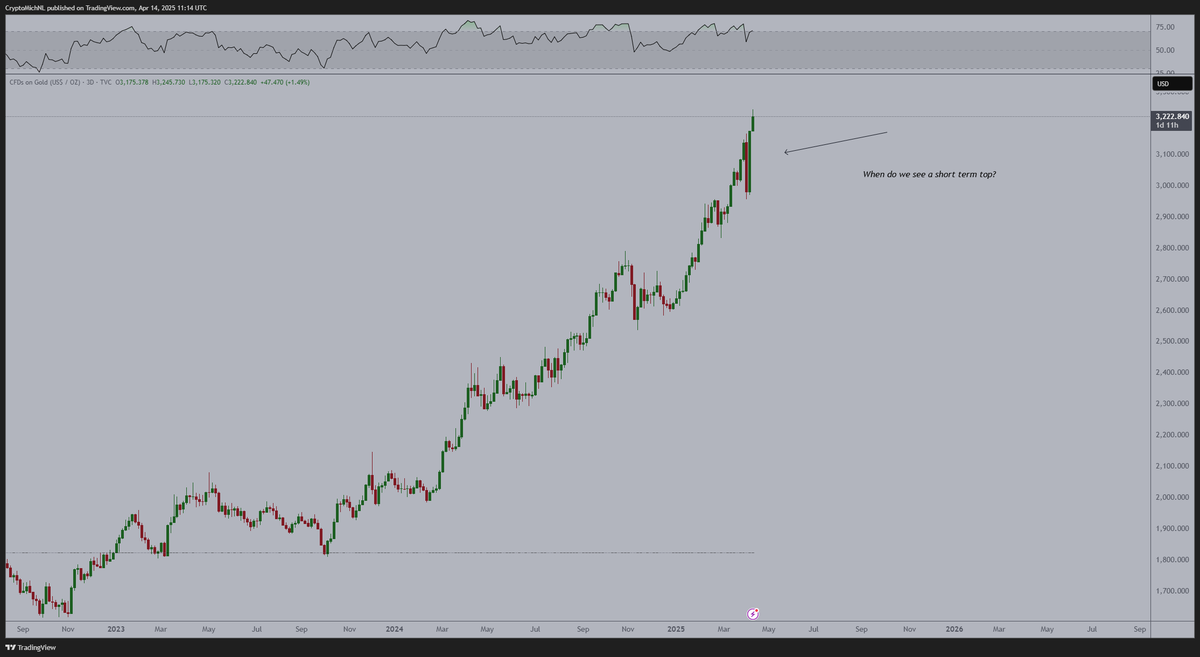
The analyst also says that ETH’s Relative Strength Index (RSI) indicator is flashing bullish, having entered oversold territory.
The RSI is a momentum oscillator used to determine whether an asset is oversold or overbought. The RSI’s values range from zero to 100. A level between 70 and 100 indicates that an asset is overbought. The 0 to 30 level range indicates that an asset is oversold.
“It’s been a bear market for 1,225 days for ETH, as, in this period, gold did a 2x. The lowest RSI on the weekly candle for ETH as well.”
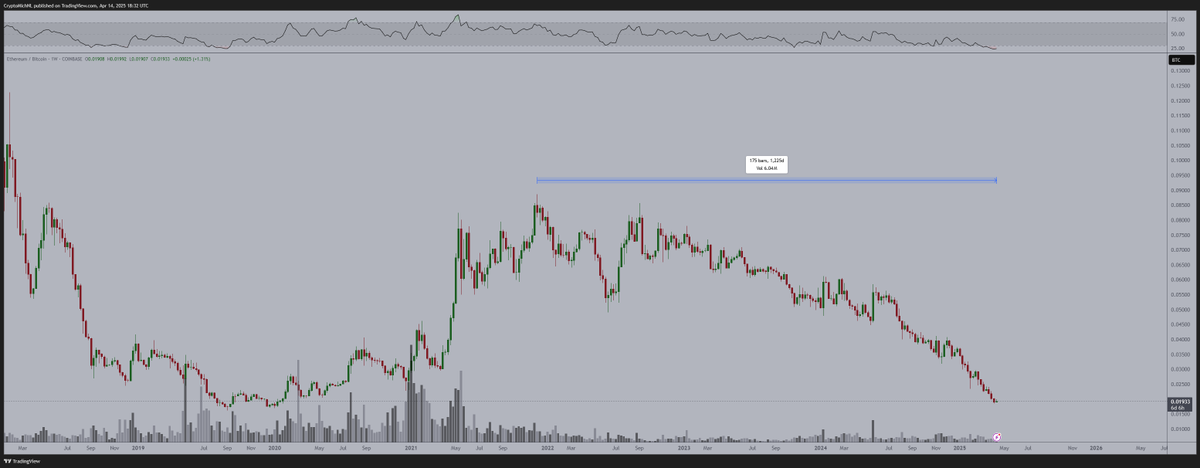
ETH is trading for $1,589 at time of writing, down 2% in the last 24 hours.
Follow us on X, Facebook and Telegram
Don’t Miss a Beat – Subscribe to get email alerts delivered directly to your inbox
Check Price Action
Surf The Daily Hodl Mix
 

Disclaimer: Opinions expressed at The Daily Hodl are not investment advice. Investors should do their due diligence before making any high-risk investments in Bitcoin, cryptocurrency or digital assets. Please be advised that your transfers and trades are at your own risk, and any losses you may incur are your responsibility. The Daily Hodl does not recommend the buying or selling of any cryptocurrencies or digital assets, nor is The Daily Hodl an investment advisor. Please note that The Daily Hodl participates in affiliate marketing.
Generated Image: Midjourney
Source link
Bitcoin
Why Did Bitcoin Price (BTC) Fall on Wednesday Afternoon
Published
6 hours agoon
April 16, 2025By
admin
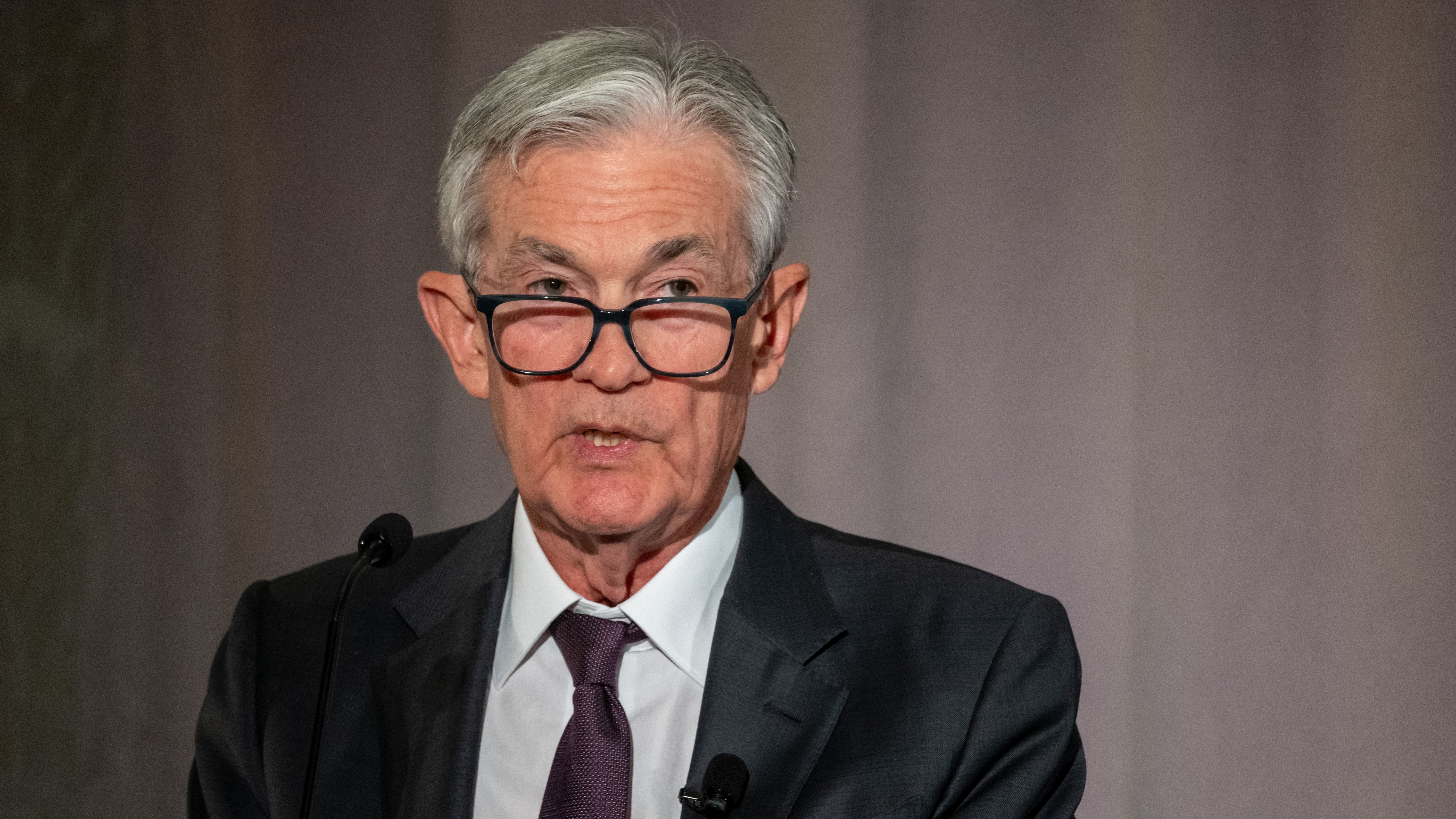
A modest bitcoin rally to a possible challenge of the $86,000 level quickly reversed during U.S. afternoon trading hours on Wednesday as Federal Reserve Chairman Jerome Powell warned on the effects of President Trump’s tariff regime.
“The level of the tariff increases announced so far is significantly larger than anticipated,” said Powell in a speech. “The same is likely to be true of the economic effects, which will include higher inflation and slower growth.”
In other words, stagflation — a throwback to a sizable portion of the 1970s when the U.S. experienced weak economic activity alongside double-digit inflation.
“We may find ourselves in the challenging scenario in which our dual-mandate goals are in tension,” continued Powell.
The price of bitcoin (BTC) fell about 2.5% in the minutes following the Powell remarks, now trading at $83,700, down 1.5% over the past 24 hours.
U.S. stocks, which had been trying to mount a comeback from opening declines, also were hit, the Nasdaq slumping 3.4% to a session low.
Powell also mentioned that as crypto is becoming more mainstream, there’s a need for a legal framework for stablecoins. He said that banking regulation around crypto will likely be “partially relaxed.”
The U.S. Senate Banking Committee cleared a bill to regulate stablecoin issuers in March, marking the first committee approval and a significant step closer to law in the U.S.
Hawkish Fed weighs on crypto and BTC
“Powell came out extremely hawkish,” Quinn Thompson, chief investment officer of hedge fund Lekker Capital, said in a Telegram message. It’s notable that Powell downplayed last week’s market turmoil characterizing it as “orderly market functioning,” he added.
“I would have at least expected him to give a nod to the elevated volatility and ruptures forming in the treasury market but he did not do that,” Thompson said.
Powell’s tone suggests that investors should temper their expectations for rate cuts in the upcoming meetings, said Thompson, which could weigh on risk assets including crypto.
“It appears a May cut is firmly off the table barring Fed intervention for bad reasons and I wouldn’t say June is a lock either,” concluded Thompson. “The bull case for crypto and bitcoin specifically is liquidity and policymaker intervention. Both of those seemed very far off based, so it’s difficult for me to paint a constructive picture in the immediate term.”
UPDATE (April 16, 18:40 UTC): Adds additional comments made by Chair Powell about stablecoins. Adds analyst comment.
Source link
Bitcoin
How Expanding Global Liquidity Could Drive Bitcoin Price To New All-Time Highs
Published
8 hours agoon
April 16, 2025By
admin
Bitcoin’s price trajectory is once again capturing headlines, and this time the catalyst appears to be global liquidity trends reshaping investor sentiment. In a recent comprehensive breakdown, Matt Crosby, Lead Analyst at Bitcoin Magazine Pro, presents compelling evidence tying the digital asset’s renewed bullish momentum to the expanding global M2 money supply. His insights not only illuminate the future of Bitcoin price but also anchor its macroeconomic relevance in a broader financial context.
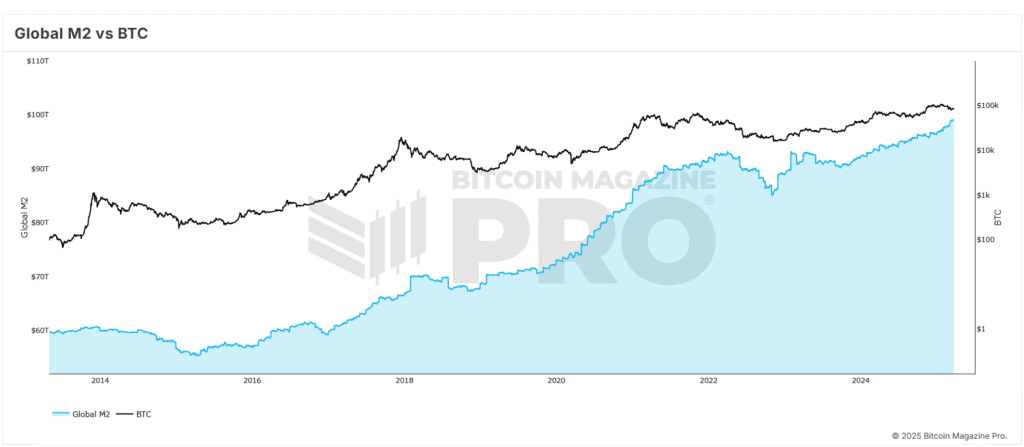
Bitcoin Price and Global Liquidity: A High-Impact Correlation
Crosby highlights a remarkable and consistent correlation—often exceeding 84%—between Bitcoin price and global M2 liquidity levels. As liquidity increases across the global economy, Bitcoin price typically responds with upward movement, although with a noticeable delay. Historical data supports the observation of a 56–60 day lag between monetary expansion and Bitcoin price increases.
This insight has recently proven accurate, as Bitcoin price rebounded from lows of $75,000 to above $85,000. This trend closely aligns with the forecasted recovery that Crosby and his team had outlined based on macro indicators, validating the strength and reliability of the correlation driving Bitcoin price upward.
Why the 2-Month Delay Impacts Bitcoin Price
The two-month delay in market response is a critical observation for understanding Bitcoin price movements. Crosby emphasizes that monetary policy and liquidity injections do not immediately affect speculative assets like BTC. Instead, there is an incubation period, typically around two months, during which liquidity filters through financial systems and begins to influence Bitcoin price.
Crosby has optimized this correlation through various backtests, adjusting timeframes and offsets. Their findings indicate that a 60-day delay yields the most predictive accuracy across both short-term (1-year) and extended (4-year) historical Bitcoin price action. This lag provides a strategic advantage to investors who monitor macro trends to anticipate Bitcoin price surges.
S&P 500 and Its Influence on Bitcoin Price Trends
Adding further credibility to the thesis, Crosby extends his analysis to traditional equity markets. The S&P 500 exhibits an even stronger all-time correlation of approximately 92% with global liquidity. This correlation strengthens the argument that monetary expansion is a significant driver not just for Bitcoin price, but also for broader risk-on asset classes.
By comparing liquidity trends with multiple indices, Crosby demonstrates that Bitcoin price is not an anomaly but part of a broader systemic pattern. When liquidity rises, equities and digital assets alike tend to benefit, making M2 supply an essential indicator for timing Bitcoin price movements.
Forecasting Bitcoin Price to $108,000 by June 2025
To build a forward-looking perspective, Crosby employs historical fractals from previous bull markets to project future Bitcoin price movements. When these patterns are overlaid with current macro data, the model points to a scenario where Bitcoin price could retest and potentially surpass its all-time highs, targeting $108,000 by June 2025.
This optimistic projection for Bitcoin price hinges on the assumption that global liquidity continues its upward trajectory. The Federal Reserve’s recent statements suggest that further monetary stimulus could be deployed if market stability falters—another tailwind for Bitcoin price growth.
The Rate of Expansion Affects Bitcoin Price
While rising liquidity levels are significant, Crosby stresses the importance of monitoring the rate of liquidity expansion to predict Bitcoin price trends. The year-on-year M2 growth rate offers a more nuanced view of macroeconomic momentum. Although liquidity has generally increased, the pace of expansion had slowed temporarily before resuming an upward trend in recent months.

This trend is strikingly similar to conditions observed in early 2017, just before Bitcoin price entered an exponential growth phase. The parallels reinforce Crosby’s bullish outlook on Bitcoin price and emphasize the importance of dynamic, rather than static, macro analysis.
Final Thoughts: Preparing for the Next Bitcoin Price Phase
While potential risks such as a global recession or a significant equity market correction persist, current macro indicators point toward a favorable environment for Bitcoin price. Crosby’s data-driven approach offers investors a strategic lens to interpret and navigate the market.
For those looking to make informed decisions in a volatile environment, these insights provide actionable intelligence grounded in economic fundamentals to capitalize on Bitcoin price opportunities.
For more deep-dive research, technical indicators, real-time market alerts, and access to a growing community of analysts, visit BitcoinMagazinePro.com.

Disclaimer: This article is for informational purposes only and should not be considered financial advice. Always do your own research before making any investment decisions.
Source link

Crypto Trader Says Solana Competitor Starting To Show Bullish Momentum, Updates Outlook on Bitcoin and Ethereum

weakness signals move toward lower support

Now On Sale For $70,000: The World’s First Factory Ready Open-Source Humanoid Robot

What Next for ETH as Traders Swap $86M into Solana DeFi protocols ?

Why Did Bitcoin Price (BTC) Fall on Wednesday Afternoon

Solana price is up 36% from its crypto market crash lows — Is $180 SOL the next stop?

Solana Retests Bearish Breakout Zone – $65 Target Still In Play?

How Expanding Global Liquidity Could Drive Bitcoin Price To New All-Time Highs

Apple Delists 14 Crypto Apps in South Korea Including KuCoin and MEXC Exchanges Amid Regulatory Crackdown

Athens Exchange Group eyes first onchain order book via Sui

Futureverse Acquires Candy Digital, Taps DC Comics and Netflix IP to Boost Metaverse Strategy
Court Grants Ripple And SEC’s Joint Motion To Suspend Appeal

AVAX Falls 2.1% as Nearly All Assets Trade Lower

What is a VTuber, and how do you become one in 2025?

Top Expert’s Update Sets $10 Target

Arthur Hayes, Murad’s Prediction For Meme Coins, AI & DeFi Coins For 2025

Expert Sees Bitcoin Dipping To $50K While Bullish Signs Persist

Aptos Leverages Chainlink To Enhance Scalability and Data Access

Bitcoin Could Rally to $80,000 on the Eve of US Elections

Crypto’s Big Trump Gamble Is Risky

Institutional Investors Go All In on Crypto as 57% Plan to Boost Allocations as Bull Run Heats Up, Sygnum Survey Reveals

Sonic Now ‘Golden Standard’ of Layer-2s After Scaling Transactions to 16,000+ per Second, Says Andre Cronje

3 Voting Polls Show Why Ripple’s XRP Price Could Hit $10 Soon

Ripple-SEC Case Ends, But These 3 Rivals Could Jump 500x

Has The Bitcoin Price Already Peaked?

The Future of Bitcoin: Scaling, Institutional Adoption, and Strategic Reserves with Rich Rines

A16z-backed Espresso announces mainnet launch of core product

Xmas Altcoin Rally Insights by BNM Agent I

Blockchain groups challenge new broker reporting rule

I’m Grateful for Trump’s Embrace of Bitcoin
Trending

 24/7 Cryptocurrency News5 months ago
24/7 Cryptocurrency News5 months agoArthur Hayes, Murad’s Prediction For Meme Coins, AI & DeFi Coins For 2025

 Bitcoin3 months ago
Bitcoin3 months agoExpert Sees Bitcoin Dipping To $50K While Bullish Signs Persist
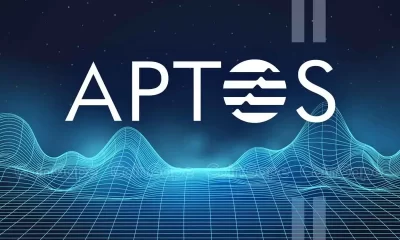
 24/7 Cryptocurrency News3 months ago
24/7 Cryptocurrency News3 months agoAptos Leverages Chainlink To Enhance Scalability and Data Access

 Bitcoin5 months ago
Bitcoin5 months agoBitcoin Could Rally to $80,000 on the Eve of US Elections

 Opinion5 months ago
Opinion5 months agoCrypto’s Big Trump Gamble Is Risky

 Bitcoin5 months ago
Bitcoin5 months agoInstitutional Investors Go All In on Crypto as 57% Plan to Boost Allocations as Bull Run Heats Up, Sygnum Survey Reveals

 Altcoins3 months ago
Altcoins3 months agoSonic Now ‘Golden Standard’ of Layer-2s After Scaling Transactions to 16,000+ per Second, Says Andre Cronje
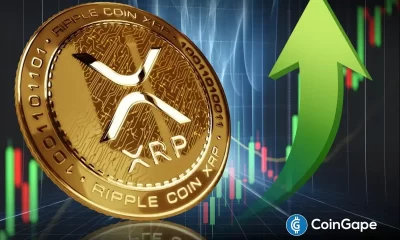
 Ripple Price4 weeks ago
Ripple Price4 weeks ago3 Voting Polls Show Why Ripple’s XRP Price Could Hit $10 Soon


